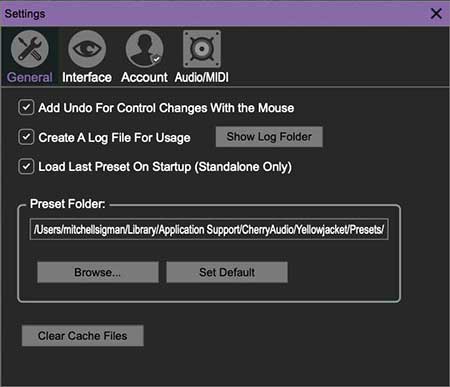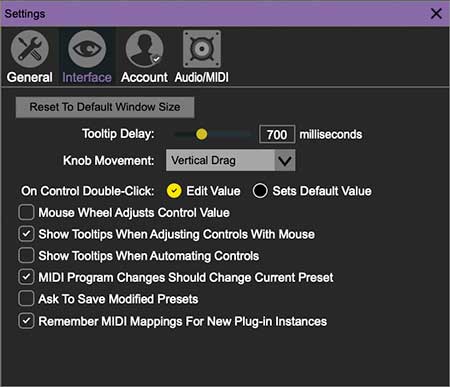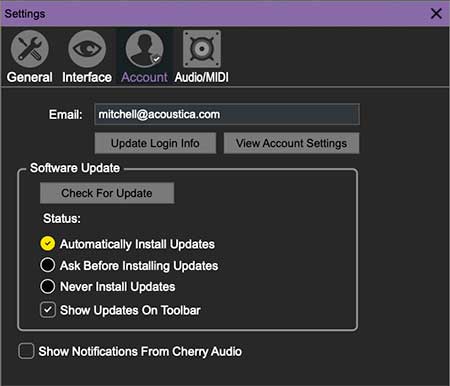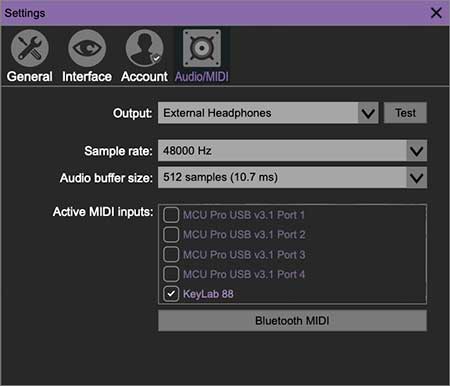Clicking the settings gear opens a window with multiple tabs for configuring various "under-the-hood" settings. These are mostly set-and-forget kind of parameters - all the stuff you'll want to tweak are on the two panel, as it should be!

Add Undo For Control Changes With the Mouse- Enabling this allows undo of knob/slider/button adjustments. You’ll want this on if you want the ability to undo all aspects of patch editing and programming.
Create A Log File For Usage- This creates a text doc of all of Yellowjacket's internal and routines during use. It is mainly intended for our tech staff should you experience any issues. Clicking Show Log Folder opens the folder containing Yellowjacket log file docs.
Load Last Preset On Startup (Standalone Only)- Automatically loads the last preset used when Yellowjacket standalone version is started.
Preset Folder- Displays the current location of Yellowjacket's sound presets. This can be changed by clicking and typing in the field.
Browse... - Displays the current location of preset folder in the file manager.
Set Default- Sets the current displayed Preset Folder path as the default location
Clear Cache Files- Deletes all log files, temporary sounds, and the image cache.
Interface

Allows customization of Yellowjacket’s user interface settings.
Reset To Default Window Size- Resets the Yellowjacket workspace to default size. Use this to reset the window size if the window somehow becomes too large for your display and can't be resized (pretty sure we fixed that bug a while back though!).
Tooltip Delay- Tooltips are those informative bits of text that pop up when hovering over a control (go ahead and try it, we’ll wait…). The Tooltip Delay setting defines how long you must hover before the tooltip pops up.
Knob Movement- Defines how mouse movements relate to turning onscreen knobs. It defaults to Vertical Drag, but can be changed to Horizontal Drag, or Rotary Drag if you're one those folks that cut their teeth on the Steinberg Model E VST back in 2000.
On Control Double-Click- Defines what happens when the mouse is double-clicked on a control. If Edit Value is selected, an exact number can be entered by typing the number and hitting [ENTER] or [RETURN]. If Sets Default Value is selected, double-clicking a control resets it to its default value.
Mouse Wheel Adjusts Control Value- Enabling this lets you adjust knob, slider, and switch values by moving the mouse wheel. This works great with a standard mouse wheel, but you'll want to disable it if you're using an Apple Magic Mouse (which will move the control AND scroll the window).
Show Control Tooltips When Adjusting Controls With Mouse- Displays parameter tooltips/values when the mouse is hovered over a control or as a control is moved with mouse clicked.
Show Tooltips When Automating Controls- Displays parameter tooltips/values next to controls any time a control is changed, i.e. if a control is moved via an assigned MIDI controller or a Perform panel knob, etc.
MIDI Program Changes Should Change Current Preset- Allows MIDI program change messages to change Yellowjacket patches.
Ask To Save Modified Presets- This opens a dialog window asking if you'd like to save changes if a patch has been edited and a new patch is selected. If you're the type that likes to click through presets and tweak a control here and there, it can be annoying to have a window pop-up asking if you'd like to save every time you switch presets - if you're that person, keep this off.
Remember MIDI Mappings For New Plug-in Instances- When enabled, Yellowjacket remembers all global MIDI Tab controller settings.
Account

Settings for your personal login information and account.
Email- Displays the email address of the current login.
Update Login Info- No, this isn’t a place for news and tour dates for yacht rock superstar, Kenny Loggins (you can keep the fire burnin' here though). Clicking this opens the same email and password login screen you’ll see when initially launching Yellowjacket.
Audio/MIDI

These are settings for audio and MIDI hardware input and output.
This tab is only visible in the standalone version of Yellowjacket.
Output- Use this drop-down menu to choose a physical audio output source. This defaults to Built-In Line Output, i.e. your computer’s onboard system audio, but you’ll get better fidelity with an external professional audio interface. The biggest audible difference is usually reduced background noise or hum, but external audio hardware also offers greater flexibility in terms of number of inputs and outputs and built-in mic or low-level instruments pres (i.e. electric guitars). The Test button will produce a sine wave when clicked; this will help with troubleshooting, aka, “WHY THE HECK ISN’T THIS MAKING ANY NOISE?!?”
Sample Rate- This sets the global sample rate. Lower sample rates offer better performance, but if you have a fast computer, high sample rates may offer slightly improved fidelity (at the very least, they'll give you something to bicker about on gearspace.com).
Audio Buffer Size- As with any digital audio app, this defines performance vs. note latency, and will largely depend upon computer CPU speed. A professional external audio interface will almost always exhibit better performance than “built-in” system audio. Lower settings will result in less latency (in the form of faster response to notes played), but will increase the chances of audio gapping or crackling noise.
Active MIDI Inputs- Enable MIDI input sources, i.e. MIDI/USB keyboards, pad controls, MIDI knob/fader control surfaces, etc. Check boxes to enable one or more devices. If a MIDI/USB controller isn't working in standalone mode, make sure the appropriate box is checked here. (We put this this piece of info way at the back of the manual, to make it extra challenging to figure out why things aren't working.)